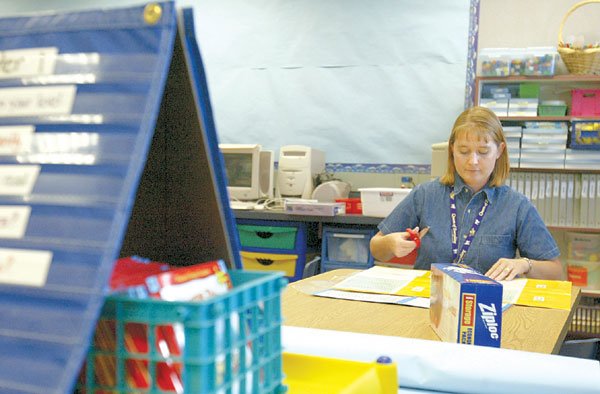Gilroy
– On Monday, Gilroy students will walk into classrooms and, with
any luck, be ready to go. In their backpacks, they’ll have binders,
notebooks, and pencils.
Their classrooms will be ready for them, too.
By Lori Stuenkel
Gilroy – On Monday, Gilroy students will walk into classrooms and, with any luck, be ready to go. In their backpacks, they’ll have binders, notebooks, and pencils.
Their classrooms will be ready for them, too.
In Erin Bywater’s first grade classroom at Antonio Del Buono, each student will sit down at a table and find a 70-sheet notebook, a box of crayons, and a pencil box with items like erasers and a clothespin.
Just as parents know that August means spending countless dollars on back-to-school supplies from clothes to backpacks, teachers feel the crunch, too.
Gilroy Unified School District teachers said they spend anywhere from a couple hundred to a couple thousand dollars of their own money on classroom supplies each year, but they’re quick to add that it’s something they simply need to do.
“As the year goes on, if students don’t have things, I don’t want them to go without,” said Dawn O’Conner, who teaches life science to seventh graders at Ascencion Solorsano Middle School.
“It’s those ‘Aha!’s’,” said Bywater, in her second year of teaching full-time. “To see the kids go ‘Aha!’ when they use the materials that I bought because I knew it would help them get a concept.”
Both teachers said they spend a couple hundred dollars of their own money each year to stock their classrooms.
Schools in the district give teachers a stipend at the start of each year, from $150 to $500, for basic supplies, like crayons, markers and glue.
But in visiting teachers’ classrooms, it becomes clear that much more is needed to make the year run smoothly.
“It’s never enough,” said O’Conner, who is returning to her eighth year of teaching after a five-year hiatus. “You just gather things over the years because you know you’ll need it.”
In Bywater’s classroom, 20 clear plastic supply tubs – below tables or up on shelves – hold supplies she’ll use throughout the year, including books or art supplies. In Anisha Munshi’s classroom at Luigi Aprea Elementary School, the walls are covered in colorful posters, curtains hang in the window and an extra small table sits in the corner.
Some items must be replenished anew each year, though, like tissues, notebooks, and “big hits” like antibacterial soap or disinfectant wipes.
Plus, teachers no longer may rely on two tax credits that off-set expenses on such items: A federal $250 income tax deduction expired this year, and the state’s Teacher Retention Tax Credit – which reimbursed up to $1,500 per teacher – was cut to eliminate the budget deficit.
Luigi Aprea Principal Sergio Montenegro agrees that teachers at his school can be limited by the $200 supply stipend they receive. Schools give supply money on a per-pupil basis.
“We don’t have a lot of extra funding sources available, so we have to use other resources like the Parent Club,” Montenegro said. “I remember back to being in the classroom – it’s never enough.”
Teachers give much credit to their schools’ parent clubs for keeping their classrooms as stocked as possible.
“They give us money per student for supplies beyond what the kids bring in,” said Karen Chavez, a second grade teacher at Del Buono.
Parent clubs provide teachers funds for field trips, sometimes contribute as much or more than the school stipend, and try to fulfill “wish lists” of supplies.
First- year GUSD teacher Courtney Hope said she was surprised at the parent club support because in Santa Maria schools, where she interned, teachers couldn’t solicit supplies from parents.
Munshi said being at a school in northwest Gilroy, with newer and more expensive homes, could mean her list gets fulfilled more so than at other schools.
“Most of the kids at Luigi have everything they need,” she said. “Most of the parents here are very generous … we get a lot of donations, or kids sharing things with each other.”
Socioeconomic differences can come into play not only in how much parent clubs can contribute, but also in how many students come to school with their own basic supplies.
As a new teacher starting at Glen View Elementary three years ago, Munshi said she spent about twice as much as she does now, at Luigi. There were more students who relied solely on her classroom materials.
Teachers can also expect to dig a little deeper into their pockets at the start and throughout the year if they are just starting out. Beginning teachers – who earn the lowest salaries, starting at $36,758 – need to stock and decorate an empty room. They used to get an extra $150 stipend from the district to help cover the additional expense of stocking an empty room, but that was cut during budget reductions.
“There’s never enough money,” echoed Superintendent Edwin Diaz.
He said the district would like to target the issue through fundraising. This year,
GUSD’s Education Foundation merged with the Gilroy Foundation, and he wants to take advantage of the better interest rates to directly help teachers buy supplies.
“(We would be) targeting donations so that they go into the category of instruc-
tional supplies in that once a year, we can start on a per-teacher basis an amount that would be a result of donations and community involvement,” he said.
Until an unlimited source of money becomes available, Terri Faus, says she’ll “Beg, Borrow, Buy” for her classroom, or “number-one charity.”
The fourth grade teacher at Del Buono said she spends $2,000 a year on her room – and she saves receipts. But it’s all part of the job she loves.
“We’re so driven to get (students) learning that we don’t even think about it,” Faus said.















